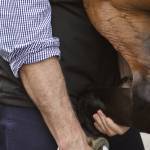Stifle Lameness: Don’t Take Shortcuts in Diagnosis

Lameness ranks among the most common reasons horses are visited by veterinarians. Musculoskeletal pains, strains, or injuries run rampant, likely explaining why joint supplements remain some of the most popular nutritional products on the market. Examples include chondroitin sulfate/glucosamine combinations, hyaluronic acid, and omega-3 fatty acids.
When prophylactic use of joint supplements fails to keep lameness at bay, veterinarians should be called in to conduct thorough physical and lameness examinations.
Veterinarians frequently start at the hoof and work their way up when trying to isolate the origin of a lameness, as most problems occur in the lower leg. In some instances, a veterinarian may be immediately suspicious of lameness higher in the limb—the stifle, perhaps—and skip straight to that joint instead of taking the “bottom-up” approach. Other times, veterinarians use anesthetic blocks to numb nerves serving specific anatomic regions.
One of the main concerns associated with nerve and joint blocks involves diffusion of anesthetic from the target location. For example, anesthesia placed inside the stifle joint can leak out of the joint, numbing surrounding peripheral nerves.
If this occurs and lameness improves after blocking the stifle joint, the real lameness could still actually be in the lower limb due to accidental blocking of the nerves coursing past the stifle joint.
While it may seem unlikely that blocking the stifle joint can mask lameness in the lower limb, a recent study* published by veterinarians from the Cornell University College of Veterinary Medicine confirmed this phenomenon.
The researchers found that intra-articular stifle anesthesia could reduce hoof pain. They did note, however, that “a significant improvement in lameness (>50%) within 30 minutes of blocking the stifle joint is likely due to stifle-related pain, whereas a significant improvement in lameness after 30 minutes has poor accuracy in differentiating stifle-related pain from distal limb pain. There is a risk that improvement in lameness following stifle anesthesia can lead to a false diagnosis of stifle joint.”
“Regardless of whether the source of the lameness ends up being stifles, hocks, knees, ankles, or any other joint in the equine limb, look to Kentucky Equine Research for research-backed supplements to help keep joints free-moving and healthy,” said Catherine Whitehouse, M.S., a nutrition advisor for Kentucky Equine Research.
“Remember to consider other ways to protect joints, such as weight management and routine exercise,” Whitehouse added.
*Radtke, A., L.A. Fortier, S. Regan, et al. Intra-articular anaesthesia of the equine stifle improves foot lameness. Equine Veterinary Journal. In press.








